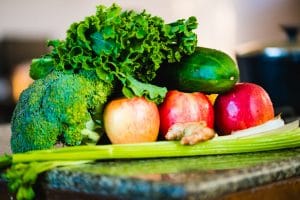The #1 Difference Between Serving Sizes & Portion Sizes
Posted by PM Admin on 25th Feb 2021
In the health and fitness world, there is a lot of different jargon that people use, and if you do not understand what the various terms mean, it can be hard to really keep up with what experts are saying.
Two commonly confused terms are portion size and serving size. Many people think they are the same thing and therefore use the terms interchangeably, but in actuality, they are not. Occasionally a good portion size does equal the serving size, but often they do not equate at all.
What is Serving Size?
You will find the serving size for a type of food on the nutrition facts label, generally above where the total calories per serving are listed[1]. The serving size is a measured amount that the manufacturer determined.
Theoretically, it is supposed to describe the amount of that food that the average person eats, but that is not necessarily the case. For example, most cans of soup have a serving size of 1/2 a can, but in actuality, many people eat the whole can. In summary, the serving size is a recommended amount determined by the manufacture that you have no control over.
What is Portion Size?
On the other hand, portion size is something that is variable and that you have complete control over. Your portion is how much you choose to eat[1].
If you sit down for a snack and you eat two chips, your portion was two chips. However, if you sit down for a snack and eat an entire back of chips, your portion was the entire bag.
The actual portion size that people are eating has been growing over time. However, the expertly recommended portion size for a person depends on various factors, including age, weight, height, sex, etc. As mentioned previously, sometimes the recommended portion size equates to the serving size, but more often than not, they are not the same.
What Is The Difference Between Serving Sizes And Portion Sizes?
A serving size is the recommended amount of food to eat based on nutritional facts. Portion size is the amount of food that you put on your plate. The easiest way to explain the differences between serving sizes and portion sizes is this: A serving size is a recommended amount of food that may or may not be the right amount of food for you to eat, portion size is the actual amount of food you eat, which can be the right amount, or more or less than you actually need.
For many, this critical difference between a recommended serving and the actual portion size becomes a problem. The best way to lose or manage weight is to ensure that portions are the right size, regardless of what a recommended serving size may suggest.
Why Is Portion Control Important?
Portion Control Is Beneficial Because It Can Help:
Improve Digestion
Eating large portion sizes to the point where you are overfull can lead to discomfort and indigestion. If you have more food in front of you than a healthy portion, you will likely eat all of it before you even realize that you are full. When you eat a controlled portion size, your digestive system will not become overloaded, and therefore it will function properly. This will also cut down on feelings of bloating and cramping.
Balance Blood Sugar
When we overeat, we often overload our bodies with glucose which can lead to imbalanced blood sugar. Imbalanced blood sugar can then grow into more serious problems like insulin resistance, a major factor in diabetes. When you eat smaller portions or the portion size meant for your body, your glucose levels will stay where they are supposed to be, and your blood sugar will be much more balanced.
Increase Weight Loss
One of the main reasons people start to think about their portion sizes is because they are trying to lose weight. Even when you are eating healthier foods, if you are eating portion sizes that are way too large, you will struggle to lose weight. Paying attention to portion sizes can also allow you to still eat your favorite "unhealthy" foods in moderation while losing weight. Whether you are eating almonds or ice cream, too much is too much.
Save More Money
An indirect benefit of eating the correct-sized portion that many people do not think about is that you will likely end up saving money on your grocery bill. When you eat the correct amount of chips or trail mix or juice, suddenly those grocery items will end up lasting you a lot longer. Additionally, when you pay more attention to portion sizes while eating out, you will either have leftovers (two meals in one), or you will buy smaller and, therefore, less expensive meals.
What is a Proper Portion Size?

The size of your portions should depend a lot on how many calories you should eat in a day, which is a very variable measurement depending on your age, gender, how active you are, your weight, etc.
There are a lot of recommendations online about how much you should be eating based on all those factors, but if you want an exact amount, you can also talk to a doctor. However, if you do not want to focus on calories or do a lot of math, simply downsizing your portions or using the Adjustable Portion Control Plate can help you.
When to Use Serving Size?
There are some benefits for looking at the serving size, even if it does not always provide you with exactly what your portion size should be. First of all, it helps you figure out how many calories you are eating and how many different nutrients you are getting. This is really helpful for people who like to track what they are eating.
For instance, a nutrition label will tell you how many unsaturated fats are in a serving size. If your portion is double the serving size, you know you are eating the number of calories listed times two and the amount of unsaturated fats times two. If your portion size is half the serving size, then you are eating the number of calories divided by two and the number of unsaturated fats divided by two.
Serving sizes can also help you when you are not sure what the portion size should be. As previously said, a serving size is not a completely accurate depiction of what your portion size should be 100% of the time, but when you do not know and do not have time to necessarily figure it out, the serving size is a great place to start.
Some people actually control their portion sizes by saying that they will eat the serving size or less, though that method does not work for everybody as some people's healthy portion size may actually be more than the serving size.
How To Portion Control Effectively
While you should now have an understanding of what a portion size versus a serving size is, you may still feel lost when it comes to controlling your own portion sizes. However, there are some things that you can do to help control your portion sizes.
Learning how to control portion sizes is one of the best things you can do to impact your weight loss goals. Here are six effective ways to help you control portion sizes.
6 Effective Ways To Portion Control
Meal Prep
Meal prepping is when you make meals for the next few days or next week in advance. This ensures you have easy healthy meals on hand, and you can measure out the portions when you package them. Meal prepping this way means that when it is time to eat, you already know how much you need to eat and can grab it quickly.
Track Food
Sometimes just staying mindful of the food you are eating by tracking it can help you eat better portions. You can write it down in an actual journal or use an app. What you track is also up to you. Some people like to track calories, while other people prefer just to track what they are eating without giving extra concern to calories, amount of fats, etc.
Add Veggies

When you go to plate your food, if you start by adding extra vegetables, your plate will look fuller without adding too many extra calories. A healthy portion of vegetables can be a lot bigger than a healthy portion of carbs or meat. We call the greens portion of the Portions Master Plate the "all you can eat" section.
Similarly, if you do not want to eat more veggies, try using a smaller plate. Once again, this can help your mind adapt to what proper portions actually look like without eating a full, large plate of calories.
Share Meals
When you go out, consider sharing a meal with someone else. Often meals at restaurants come in portion sizes that are really 2-3 times the amount that you need to be eating. Sharing your food can help you avoid eating too much. If you can't share, you can also consider asking for a smaller portion or asking to box half your dinner up before you start eating.
Avoid Mindless Eating
Studies have shown that when people are bored or focused on something else, they tend to start mindlessly eating. For example, if there is a bag of chips beside them, they may keep eating far beyond when they usually would because they do not notice what they are doing. Being very conscious of what you are eating by measuring out snacks or not multitasking while eating can be really beneficial.
Use The Adjustable Portion Control Plate
Finally, using tools to help measure out your portion sizes can be really helpful. The most effective is the Adjustable Portion Control Plate. You can adjust this plate to present you with spaces for the number of proteins, carbs, and vegetables you want to eat based on your goal weight. Then, when you want to eat, all you have to do is fill-up the proper sections to feel confident that you are eating a healthy portion for you and your goals.
Click Here To Buy Now!
Having to do a lot of tracking and math can be really frustrating when you are ready to eat dinner. With the Portion Control Plate, you get to eliminate that frustration and control your portions quickly and easily.


